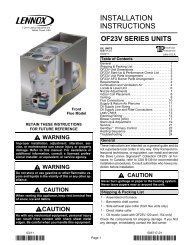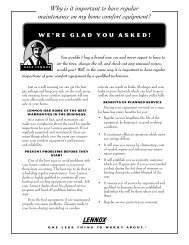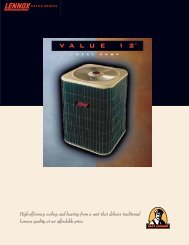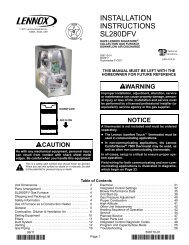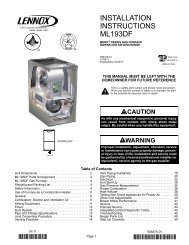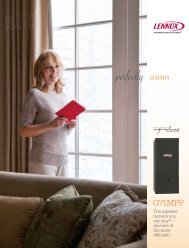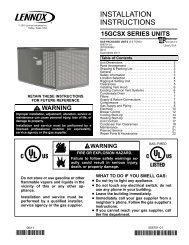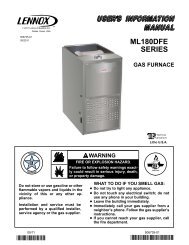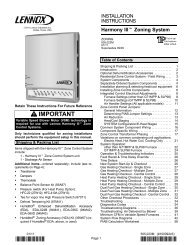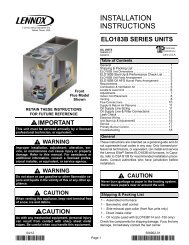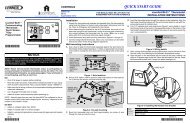INSTALLATION INSTRUCTIONS - Lennox
INSTALLATION INSTRUCTIONS - Lennox
INSTALLATION INSTRUCTIONS - Lennox
You also want an ePaper? Increase the reach of your titles
YUMPU automatically turns print PDFs into web optimized ePapers that Google loves.
• Place the furnace as close to the center of the air distribution<br />
system as possible. The furnace should also be<br />
located close to the chimney or vent termination point.<br />
• When the furnace is installed in non−direct vent applications,<br />
do not install the furnace where drafts might blow<br />
directly into it. This could cause improper combustion<br />
and unsafe operation.<br />
• When the furnace is installed in non−direct vent applications,<br />
do not block the furnace combustion air opening<br />
with clothing, boxes, doors, etc. Air is needed for proper<br />
combustion and safe unit operation.<br />
• When the furnace is installed in an attic or other insulated<br />
space, keep insulation away from the furnace.<br />
• When the furnace is installed in an unconditioned<br />
space, consider provisions required to prevent freezing<br />
of condensate drain system.<br />
CAUTION<br />
G43UF unit should not be installed in areas normally<br />
subject to freezing temperatures.<br />
WARNING<br />
Product contains fiberglass wool.<br />
Disturbing the insulation in this product during<br />
installation, maintenance, or repair will expose you<br />
to fiberglass wool. Breathing this may cause lung<br />
cancer. (Fiberglass wool is known to the State of California<br />
to cause cancer.)<br />
Fiberglass wool may also cause respiratory, skin,<br />
and eye irritation.<br />
To reduce exposure to this substance or for further<br />
information, consult material safety data sheets<br />
available from address shown below, or contact your<br />
supervisor.<br />
<strong>Lennox</strong> Industries Inc.<br />
P.O. Box 799900<br />
Dallas, TX 75379−9900<br />
Combustion, Dilution & Ventilation Air<br />
If the G43UF is installed as a Non−Direct Vent Furnace,<br />
follow the guidelines in this section.<br />
NOTE − In Non−Direct Vent installations, combustion air<br />
is taken from indoors and flue gases are discharged out−<br />
doors.<br />
WARNING<br />
Insufficient combustion air can cause headaches,<br />
nausea, dizziness or asphyxiation. It will also cause<br />
excess water in the heat exchanger resulting in rusting<br />
and premature heat exchanger failure. Excessive<br />
exposure to contaminated combustion air will result<br />
in safety and performance related problems. Avoid<br />
exposure to the following substances in the combustion<br />
air supply:<br />
Permanent wave solutions<br />
Chlorinated waxes and cleaners<br />
Chlorine base swimming pool chemicals<br />
Water softening chemicals<br />
De−icing salts or chemicals<br />
Carbon tetrachloride<br />
Halogen type refrigerants<br />
Cleaning solvents (such as perchloroethylene)<br />
Printing inks, paint removers, varnishes, etc.<br />
Hydrochloric acid<br />
Cements and glues<br />
Antistatic fabric softeners for clothes dryers<br />
Masonry acid washing materials<br />
In the past, there was no problem in bringing in sufficient<br />
outdoor air for combustion. Infiltration provided all the air<br />
that was needed. In today’s homes, tight construction<br />
practices make it necessary to bring in air from outside<br />
for combustion. Take into account that exhaust fans, appliance<br />
vents, chimneys, and fireplaces force additional<br />
air that could be used for combustion out of the house.<br />
Unless outside air is brought into the house for combustion,<br />
negative pressure (outside pressure is greater than<br />
inside pressure) will build to the point that a downdraft<br />
can occur in the furnace vent pipe or chimney. As a result,<br />
combustion gases enter the living space creating a potentially<br />
dangerous situation.<br />
In the absence of local codes concerning air for combus−<br />
tion and ventilation, use the guidelines and procedures in<br />
this section to install G43UF furnaces to ensure efficient<br />
and safe operation. You must consider combustion air<br />
needs and requirements for exhaust vents and gas pip−<br />
ing. A portion of this information has been reprinted with<br />
permission from the National Fuel Gas Code (ANSI−<br />
Z223.1/NFPA 54). This reprinted material is not the complete<br />
and official position of the ANSI on the referenced<br />
subject, which is represented only by the standard in its<br />
entirety.<br />
In Canada, refer to the CSA B149 installation codes.<br />
Page 6



